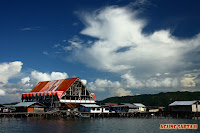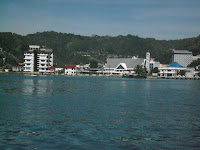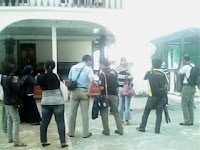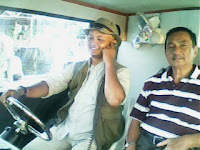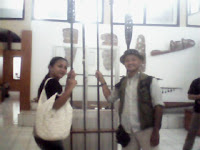Baliem
Valley and the Dani tribe
waited a long time to be discovered. Papuan highland belongs to one the most
recently explored New Guinea
areas. The tall mountains in west Papua (Irian Jaya) were generally considered
as uninhabited. No sooner than 1398 did the pilot Richard Archbold notice that
there was something special about the deep, and large valley situated among the
four-thousand meter tall mountains. In the valley there were clearly
recognizable fields, similar to those he knew from Europe.
The Baliem valley and Dani tribe were discovered by pure luck.

The Baliem Highlands is centered on the Grand Valley
some 1,600 meters above sea level. Temperatures of the highland are ranged from
26 degrees Celsius at the day time and 12 degrees at night.. The valley is 60
kilometers long and 15 kilometers wide and is surrounded on all sides by
mountain peaks rising to between 2,500 and 3,000 meters.This valley has been
the most visited part of the island, especially in recent years. This valley is
home to the Dani tibesmen. They are living in primitive way of farming.
Baliem
Valley, is a spectacular
valley which an ideal location for our innovative trek that follows trails
through the jungle and mountain environs of the Dani, Yali and Lani People.
Until a generation ago these stone-age tribes had little to do with the outside
world, until the arrival of white missionaries in the 1950s (a fact well
documented in Heinrich Harrer’s account of the first ascent of Carstensz
Pyramid in 1962). Even today, the Dani’s reliance on stone axes and on an
agricultural lifestyle – that evolves around raising pigs and growing root
crops – provides a fitting insight into their tribal traditions.
This spectacular valley is an ideal location for our innovative trek that
follows trails through the jungle and mountain environs of the DANI PEOPLE.
Even today, the Dani’s reliance on stone axes and on an agricultural lifestyle
– that evolves around raising pigs and growing root crops – provides a fitting
insight into their tribal traditions.
The first missionary, Loyd van Stone, parachuted
there as late as 1954. Only then did the civilization of the Baliem valley, and
Dani and Lani tribes, begin. Since then, the Baliem valley has become a gate
for discovering the west of the Papua highland. No road has been built there
yet, but in Wamana a large airport was built, and supplies are now transported
by large freight airplanes. Despite all these developments, the Baliem
valley is still dominated by the straw roofs of the Dani tribe. Danis are an
indigenous tribe, which dwelled in the Baliem valley in the time of its
discovery. Danis belong to some the “most decorative” tribes in the west Papua

You have probably seen the famous photos of Dani tribe members with boar
tusks in their noses, and headdresses made of Paradise
birds feathers. Dani men only wear long and thin kotekas. The women Danis wear
short skirts woven from orchid fibers, decorated with straw, and with
indispensable woven bags called “noken” across their backs. Similar to the
women of the Yali tribe, the Dani women wear short skirts below their butts.
Despite the fact that Danis were discovered quite
late – in 1938, they became one of the best known tribes in New Guinea.
Dani occupied one of the most fertile parts of Papua. As a result they often
had to fight for their territory. There were also frequent wars among the Danis
themselves. They were the most dreaded head-hunting tribe on the island, which
is even more remarkable if we consider that they did not eat their enemies,
like the majority of other Papuan tribes did.
you can be in a face to face contact with Dani people. Dani build
round or oval huts, and their villages are enclosed by fences. They are
farmers, and their small fields are distinctly bordered. This is what helped
Richard Archbold spot them from the plane. The Dani tribe’s customs and culture
are very rich and interesting. Several pages could be written on these topics
The main reason that the Dani tribe is so well known, is that the Baliem
valley where they live, is relatively easy to reach these days.
Wamena was a point of departure for many
expeditions. The Dani villages are visited by virtually every tourist who sets
out in west Papua. Some villages even show their original customs and hold mock
wars.
Another thing which brought fame to the Dani tribe are the several hundred
years old ”smoked” mummies of famous tribesmen. Two of them can be seen in the
Baliem valley – in Akima and Jiwika villages.
The Baliem Valley was once dubbed Shangri La and it
is easy to see why. The Valley is incredibly lush and fertile and is surrounded
on all sides by towering peaks of 2,500to 3,000 metres.
The fertility is such that the valley has been farmed for 9,000 years but it
was only discovered by westerners in 1938! There are three mains tribes
inhabiting the Baliem
Valley: The Dani in the
base, the Lani to the west and the Yali in the south-east. Each tribe has a
distinct culture. One sure and interesting way to distinguish between the
tribes is from the Koteka, or penis gourd, sported by the male members. The men
of each tribe tend to the growing of the gourds with the three tribes each
cultivating a different style. The Dani use a long, thin Koteka, the Lani sport
a medium sized, wide cannon-like gourd, and the Yali wear the longest of all.
The proposed program of we attached here allows
you to experience some trekking to deeper side of Dani’s communities at the
southern part of the magnificent valley, to encounter people who are living in
so-called STONE AGE as they are almost naked people, as well as to experience
their ancient way of live.
LETS TRY THIS MOMENT .............VISIT THE STONE AGES AND YOU WILL STAND IN THE FUTURE
